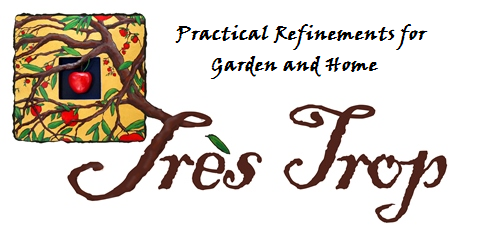Choosing a Planter - What Does the Plant Want?
Posted by Martha Ellis Kelley on
In 2005, I established Tres Trop, LLC to sell basketry hanging planters from England. In 2007, the product line expanded to include a wide array of coco fiber lined planters. To sell them, I had to know how to use them.
Successful gardening starts with the plant. To exist and prosper, the plant’s needs for temperature range, sunlight, hydration, soil composition, and nutrition must be satisfied. This can happen naturally or artificially but, if not, the plant will die or languish. Do your homework - the internet is a goldmine of information.
I live in Fauquier County, VA – Zone 7a. From 2010 through 2014, I operated a shop in Warrenton. The site was a 1930’s converted garage situated on a neglected lot of about 1/8 acre. Along the perimeter was a chain link fence covered in honeysuckle and poison oak vines and topped with rusted barbed wire. In the middle, was a huge pile of chippings from removed trees. There were three pines and one sad rhododendron.
Shop Garden Year 1 (after a lot of work):

Shop Garden July of Year 5 (after a lot of work)

The magic occurred because the plants were viable in Zone 7a and the location provided everything they wanted.
For successful container planting, START WITH THE PLANT. A planter is any container or surface adequate to hold flora and medium. Function is governed by construction, material, shape, and size.
Unglazed Pottery and Concrete: Clay and cement absorb water. Absent glazing, the water wicked from the roots and medium will evaporate on the surface of the planter. If the plant wants regular hydration, expect to water frequently or use the planter as a cachepot. If the plant is a succulent and stores water in stem and leaves, unglazed planters are tailor made. Below is a very happy "kleinia" ensconced in a clay pot with wonderful "bloom".

Glazed Pottery: Glazing is a process by which minerals and metals are burned onto clay at very high temperatures. If all surfaces are glazed and the pot is not pierced, it takes on characteristics of plastic or glass. If only the exterior surface is glazed, the planter becomes a hybrid. The interior absorbs moisture, but the glazing limits evaporation. This suits root systems designed to drink regularly.
Pottery and concrete planters are elegant. They are fragile, expensive and heavy. Freezing is a risk as the tissue absorbs water. During Winter, unless they are coming in, I empty concrete and terra cotta planters - concrete left out upside-down and the terra cotta stored in a shed.
Plastic: Plastic is light, durable, malleable, and inexpensive. These two examples are from a water garden in Kampala, Uganda. Here, the water becomes plastic.


To the left is a laundry basket planted with papyrus. To the right is a wire basket planted with nephthytis and water hyacinth. For both, plastic sheeting contains medium and mulch. In this case, as for un-pierced plastic, the only source of evaporation will be at the surface. Look closely, the papyrus is submerged but the other is not. The mulch is dry. The gardener matched need with planter.
Coco-fiber: There are three examples in this picture.

This style combines an open metal frame with matted coco-fiber. Coco fiber is inexpensive, flexible, and can hold a significant amount of soil and flora. Design possibilities are extensive with none of the weight issues of clay or concrete.
Coco fiber cannot hold water. There are potting soils and water retentive products available. The issue can be solved by lining coco fiber with landscape fabric or heavy plastic sheeting (always pierced) before planting.
To plant the stand in the image above, the tabletop was protected with a layer of plastic HVAC filter. Next came a layer of coco fiber. The planting was of succulents and a dracaena, so landscape fabric followed - two layers set crosswise. Coco fiber lined the sides and the juncture filled with moss. The mulch was white stone. All of this effort was made to retain the sandy soil mix and slow down the out-flow and evaporation of water. Succulents need time to drink.
Lining the coco fiber extends life by years. It is not indestructible, and replacements are not a sure thing. I recommend unique and large urns or tubs be treated as cachepot. Plastic utility pots are available in many shapes and sizes and the space between pot and planter can be filled with moss.
Everything else includes rocks; crevices in stone walls; wooden tubs; and steel drums. The rules are the same. Are the needs of the plant satisfied? Below, are two spontaneous plantings - in a volcanic slag heap and stone wall.


This is an unspontaneous planting of a "Crown of Thorns".

"The Crown" is planted in a black plastic pot set inside a steel planter. It is shaded in the morning and receives full late afternoon sun. The Euphorbia Milii from Madagascar is thriving in Zone 7a in a non-permeable planter which retains heat. How? The planters are pierced, and the soil amended to drain well. These roots don't mind the heat - just the cold.
Size and Shape considerations:
Height vs Base: This Fall, "The Crown" will be repotted - a terra cotta planter with a wide base. The current configuration will tip unless supported. The soil and mulch will change to address the change in planter style and composition.
Design: A shallow planter with a wide opening accelerates evaporation of water - a good combination for succulents. A deep, bowl-shaped planter holds water longer than one cone shaped - good for steady feeders.
By understanding the plant and the planter, the chances are good you will negotiate a desired combination. Your tools are temperature range, sunlight, hydration, soil composition, and nutrition What does the plant want?
Share this post
0 comment
